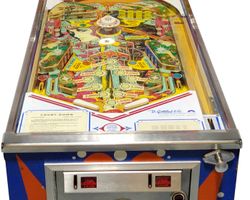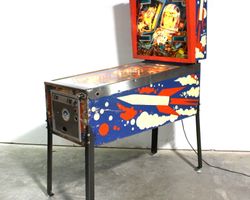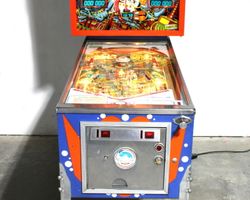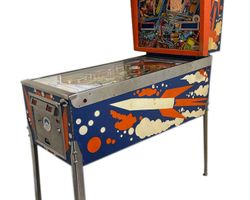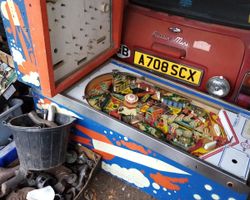Count-Down
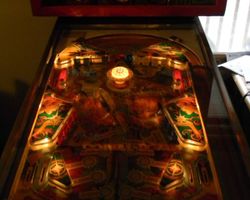
Average Prices: USD $200 to $1,100
Produced: April, 1979
Production Run: 9,900 units
Machine Type: Solid State Electronic
MPU: Gottlieb System 1
Players: 4
Design by: Ed Krynski
Art by: Gordon Morison
D. Gottlieb & Company, a name synonymous with pinball's rich history, introduced Count-Down in April 1979. This solid-state electronic (SS) machine, designated as Model Number 422, emerged during a pivotal time for the manufacturer, representing one of its most successful titles from the System 1 era. The game plunged players into a vibrant outer space theme, a popular motif that captured the public imagination in the late 1970s, fueled by contemporary science fiction.
The design of Count-Down was a collaborative effort, with Ed Krynski credited for the playfield layout and Gordon Morison for the captivating artwork. Krynski, a prolific designer for Gottlieb, brought a distinct gameplay philosophy that emphasized strategic shot-making over kinetic chaos. Morison's artistry, particularly evident in the backglass and playfield, rendered a colorful, almost comic-book style interpretation of space exploration, populating the machine with rockets, planets, and celestial bodies that resonated with the era's optimism for space. Production of Count-Down was substantial, with 9,900 units manufactured, indicating its strong market performance. This high production number made it a widely accessible game, contributing to its lasting impression. Interestingly, the playfield design for Count-Down was also adapted for an electro-mechanical (EM) counterpart released in the same year, Space Walk, highlighting a cross-platform design efficiency within Gottlieb's offerings. Early sample playfields of Count-Down featured unique aesthetic variations, such as a black stripe in the shooter lane and fully painted wood surfaces, distinguishing them from the later production models.
Signature Features and Design
Count-Down stands apart from many of its contemporaries through its singular focus on drop targets and an innovative flipper configuration. The machine boasts four flippers—two at the traditional lower position and two additional, strategically placed flippers higher on the playfield. This expanded flipper count dramatically increases the accessible areas of the playfield, empowering players with more control and shot opportunities, a significant departure from machines that relied solely on lower flippers.
The defining characteristic of Count-Down, however, is its array of 16 drop targets. These are arranged into four distinct banks of four, each typically color-coded (often green, yellow, red, and blue), creating a visual and strategic focal point. This abundance of drop targets transforms the game into a "drop target nirvana" for players who relish precision shooting. Unlike games heavily dependent on ramps or complex mechanisms, Count-Down thrives on the satisfying thud of a felled target. These features collectively enhance gameplay by creating a clear, primary objective and rewarding accurate shots, contributing to a sense of progression and mastery that remains engaging. Despite its solid-state electronics, the machine often evokes the pure, unadulterated gameplay feel of an earlier electro-mechanical era, a quality many enthusiasts find appealing.
Playfield and Mechanics
The playfield of Count-Down presents a largely symmetrical layout, designed to facilitate its core drop target mechanics. Dominating the lower-mid sections are the four banks of four drop targets. These targets are strategically positioned to encourage precise aiming from the four flippers. Successfully clearing a bank or hitting targets in a specific sequence is central to advancing in the game.
The upper reaches of the playfield feature two star rollovers, which offer scoring opportunities and direct the ball's flow. A single pop bumper provides a small element of chaotic action, contrasting with the game's otherwise target-oriented precision. A kick-out hole, typically positioned in a central or upper-central area, serves as a collection point or provides opportunities for bonus awards. Notably, Count-Down foregoes slingshots, focusing the ball's momentum and player control primarily through the flippers and target interactions. The overall flow of the playfield is less about high-speed loops or ramps and more about controlled, deliberate shots aimed at clearing target banks. This design philosophy cultivates a rewarding experience for players who enjoy testing their accuracy and strategic planning.
Gordon Morison's artwork on the playfield is vibrant and clear, utilizing a palette of blues, reds, and yellows that evoke the vastness and mystery of space. The artwork integrates seamlessly with the playfield elements, providing visual cues for targets and pathways. Lighting is effectively used to highlight active targets and scoring opportunities, guiding the player's attention without being overly complex. The aesthetic is distinctly 1970s, combining bold graphics with functional design, ensuring that the playfield is both visually appealing and highly playable.
Gameplay Dynamics
The gameplay of Count-Down is built around a deceptively simple yet deeply engaging set of mechanics centered on its numerous drop targets. The primary objective revolves around clearing the four banks of four drop targets. Each bank corresponds to a specific color (green, yellow, red, blue), and hitting them in a sequential order is key to maximizing scoring potential. As players clear these banks, they advance a bonus multiplier, typically escalating through 1x, 2x, 3x, 4x, and culminating in a significant 5x bonus. Achieving this maximum multiplier is the cornerstone of high scoring and serves as a continuous challenge.
The game's progression is straightforward: hit targets, build bonus, collect bonus. While seemingly simple, the execution demands precision and control. The presence of four flippers allows for varied shot angles and strategies. Players can opt for direct shots at targets from the lower flippers or attempt more complex, angled shots using the upper flippers to clear distant targets or activate rollovers. This emphasis on target practice makes Count-Down an excellent machine for honing fundamental pinball skills.
There are no complex multi-ball modes or intricate story-driven objectives typical of later pinball generations. Instead, the challenge lies in consistent target accuracy, managing ball control to prevent drains, and strategically choosing which targets to pursue next to maximize the bonus multiplier. The addictive nature of the game stems from its "one more try" factor; players constantly feel on the cusp of clearing the next bank, achieving the maximum bonus, or beating their previous high score. This loop of immediate feedback and clear objectives makes Count-Down highly replayable, appealing to both newcomers who can grasp its rules quickly and seasoned players seeking to master its nuances.
Reception and Legacy
Count-Down was met with overwhelmingly positive reception within the pinball community, solidifying its status as a beloved classic from the Gottlieb System 1 era. Its strengths are frequently lauded, with the machine often described as exceptionally fun, addictive, and possessing remarkable replayability. The "drop target paradise" aspect is a consistent highlight, with players reveling in the satisfying challenge of clearing all 16 targets. The four flipper setup is also a significant positive, lauded for making the entire playfield accessible and enhancing the overall gameplay flow. Many enthusiasts appreciate its blend of solid-state reliability with a gameplay feel reminiscent of earlier electro-mechanical machines, offering a pure, unadulterated pinball experience. Gordon Morison's artwork, particularly the backglass, is consistently praised as beautiful and a strong aesthetic point, contributing to the machine's visual appeal. The game's simple ruleset, which is easy to grasp, yet challenging to master, is seen as a key strength, providing depth for experienced players while remaining accessible to beginners. Its capacity to improve a player's target shooting skills is also frequently cited.
However, Count-Down is not without its points of criticism, though these are generally overshadowed by its positive attributes. The sound package is often described as simplistic, basic, or even monotonous, a common characteristic of early solid-state machines. This led many owners to seek out modifications, such as installing chime units or modern CPU boards, to enhance the audio experience. Some players also find the upper playfield difficult to access or feel that it is underutilized, wishing for more compelling reasons to aim for those shots. While generally considered a fast-playing game for its era, some note it's not a "fast pinball table" in the context of later, more frantic designs, focusing instead on deliberate shot accuracy. The potential for "drain monster" tendencies, particularly with the side drains, is acknowledged by some, requiring skill to keep the ball in play.
Despite these minor critiques, Count-Down's legacy is secure as a standout Gottlieb machine. It stands as a testament to how focused design and a strong core mechanic can create an enduring pinball experience. Its high production numbers ensured its wide availability, allowing many to experience its unique blend of precision and satisfaction. Count-Down's success and popularity in the late 1970s demonstrated Gottlieb's continued prowess in the solid-state market before the competitive landscape shifted dramatically. It remains a popular choice for collectors and a machine that continues to deliver engaging, target-driven gameplay, influencing subsequent designs that prioritize clear objectives and rewarding shot-making.
Sponsored Links
 Ebay Listings
Ebay Listings
 Auction Results
Auction Results
| Cost | Location | Date |
|---|---|---|
| USD $1,312 |  Maryland, United States Maryland, United States |
15 September, 2025 |
| USD $900 |  Georgia, United States Georgia, United States |
13 September, 2025 |
| USD $2,989 |  Florida, United States Florida, United States |
03 October, 2024 |
| USD $3,600 |  Maryland, United States Maryland, United States |
11 June, 2024 |
| USD $1,900 |  Massachusetts, United States Massachusetts, United States |
17 March, 2024 |
| GBP £805 |  Nottingham, United Kingdom Nottingham, United Kingdom |
16 October, 2023 |
| GBP £875 |  Nottingham, United Kingdom Nottingham, United Kingdom |
04 October, 2023 |
| USD $1,320 |  United States United States |
24 August, 2023 |
| GBP £500 |  Chesterfield, United Kingdom Chesterfield, United Kingdom |
31 July, 2023 |
| GBP £450 |  Warwick, United Kingdom Warwick, United Kingdom |
17 April, 2023 |


Private Policy · Search Website · Contact Us
As an eBay Partner, we may earn a commission from qualifying purchases made through links on this site, at no additional cost to you.
All trademarks and copyrighted materials remain property of their respective owners. All other content copyright 2007 - 2025 Pinpedia.

